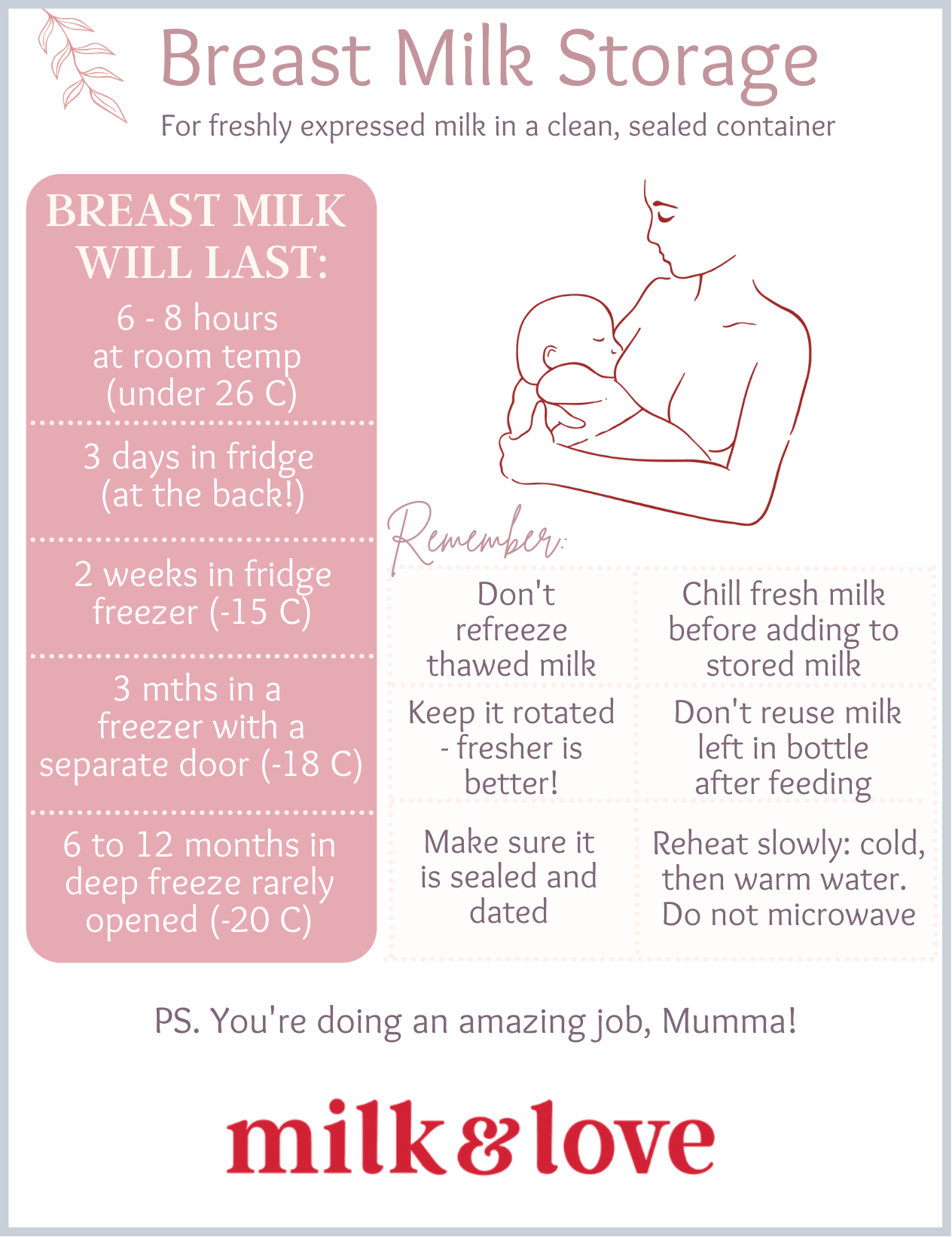Ultimate Breastmilk Storage Guidelines for Pumping Mamas
Posted by Corryn Barakat on Mar 21, 2022
Expressing breast milk is the modern mother’s boon and curse. On the one hand, you have the ability to leave your precious breastmilk for your baby if you need to leave your baby for a period of time (and of course for building up supply and a myriad of other medical reasons). On the other hand, you may feel pressure from friends, family (and partners!) to express your milk so that someone else can feed your baby, and you can get out and about when all you want to do is snuggle up with your baby.
Your Breast Milk is Constantly Changing
Interestingly, your breast milk changes constantly to deliver the perfect blend of antibodies and hormones to your baby at that time, particularly melatonin (the sleep hormone) in the evening and night to help regulate your baby’s circadian rhythms (and help them fall sleep!). In fact, even during a feed, your breast milk changes composition throughout the feed so your baby receives the perfect blend of fats and proteins to satisfy her. It is amazing stuff. Research shows that breast milk directly from the breast is the best nutrition for your baby. Expressed breast milk is a close second, but should not be the ‘norm’ for everyone the way it seems to be in our culture.
Please don’t ever feel as though you HAVE to express, because it’s the ‘done’ thing, and ‘of course you need time away from your baby’. Only express breast milk if you need to, or if you have decided it is the best solution for your family. If you have decided that you need to express and store your breast milk, there are a few things to consider.
Working Out How To Express Your Milk
While some mama's can sit down and easily express bottles of breast milk, other mums can have a lot of difficulty getting milk out. Remember that the amount you express is not an indicator of how much milk you have. Expressing your milk can be more complicated than you think, as our bodies take some time to get used to expressing milk when our babies aren’t there! Katie James, IBCLC, has previously written a couple of blogs which have some really useful tips. You can read more about why Oxytocin matters and her tips for returning to work for breastfeeding mums.
What To Store Your Precious Breast Milk In
Always make sure that any containers are washed in hot, soapy water, rinsed well and allowed to air-dry before using. Alternatively, washing and drying in the dishwasher can work as well. You can either use bottles, breast milk containers (e.g. Milk Trays), disposable breast milk bags or reusable silicone breat milk pouches. Make sure that whatever you use is designed for breast milk. We recommend using glass or silicone containers.
Using other bags or containers can introduce risks of contamination, plastic leaching and may leak. When you’re filling your containers or bags, leave an inch of space to allow milk to expand as it freezes. It’s a good idea to freeze your milk in small portions (e.g. 60 or 120ml) so you only defrost the amount you need and reduce wastage. Always write the date you expressed the milk on the container before storing.
Understand Storage Guidelines For Your Breast Milk.
You can maximise the nutritional and anti-infective qualities of your milk by giving your baby the freshest milk you have pumped. A good practice is to always use the oldest milk first to keep all of your stored milk rotated. Refrigerated milk has more anti-infective properties than frozen milk (per La Leche League). These guidelines from La Leche League International for breast milk storage are for home use for mothers with healthy, full-term babies, and who have thoroughly washed and dried their hands before expressing and storing.
Breast Milk Storage Guidelines
| Where | Temperature | Time | Comments |
| Room Temperature |
19 - 26° C
|
6 - 8 hrs* | Keep as cool as possible! Try covering with a damp cloth to keep cooler. |
| Cooler Bag / Esky |
15 - 4° C
|
24 hrs | Keep ice packs next to milk and limit opening the bag |
| Fridge |
< 4° C
|
3 days | Store at the back, away from the sides to keep as cold as possible and minimise temperature fluctuations. |
| Freezer (part of fridge) |
< -15° C
|
2 weeks | |
| Freezer (separate door to fridge) |
< 18° C
|
3 - 6 mths | |
| Deep Freeze |
< 20° C
|
6 - 12 months | Only if deep freezer |
*only when collected in very clean conditions to minimise contamination
How To Use Stored Milk
You might notice that your breast milk smells or tastes differently after storage. It is normal for the fats to separate during storage, and you can recombine them by gently swirling your milk back together. It is recommended that you do not shake the milk as this may damage the protein structures (although there is no research to prove this one way or the other at the time of writing).
Frozen Breast Milk
Slowly thawing it in the fridge is the best way to defrost, but it can take about 12 hours. You can hold the container under cool running water to help thaw, and gradually increase the temperature of the water to warm it up. Avoid leaving the milk out at room temperature to thaw.
Breast Milk from the Fridge
Some babies will drink cooled milk directly from the fridge! Otherwise you can warm it up by immersing the container in warm water. You do not need to bring the temperature to boiling point, and please do not heat milk directly on the stove or microwave! This may heat unevenly and may destroy some of the beneficial properties of your milk.
Previously Thawed Breast Milk
If you have thawed your milk, it can be kept in the fridge for up to 24 hours. Do not refreeze! Refreezing will further breakdown milk components and increase loss of antimicrobial activity.
Previously Heated Breast Milk
There is no research on the safety of reheating leftover milk from a previous feeding. It is probably safe to save for up to 1-2 hours, if your baby wakens for more milk, or still seems hungry. Be aware that as your baby feeds there is some bacterial contamination of the milk, so do discard after 1-2 hours.
Common Questions
Why does my breast milk taste soapy after storing?
If your milk smells bad or soapy after storage (and you have followed the storage guidelines), you may have excess lipase, an enzyme that breaks down fat into fatty acids to aid infant digestion. It isn’t harmful, however your baby may refuse to drink it. If this is an issue for you, you can prevent this by heating your milk to scalding straight after expressing (heat until there are bubbles around the edge but not boiling) then quickly cool and freeze. Heating milk above 40°C results in loss of all enzyme activity, but this is still preferable to formula.
Can I Add Fresh Breast Milk to Refrigerated Milk?
A lot of people ask if they can add their freshly expressed milk to milk that is already in the fridge or freezer.
It is absolutely fine to add fresh breast milk to refrigerated or frozen breast milk. You just need make sure that the fresh breast milk is cooled right down, all the way through, by placing it in the fridge for a period of time before adding it to the previously refrigerated or frozen breast milk so it doesn't warm it up.
How Long does Breast Milk Last at Room Temperature?
When you have freshly expressed your breast milk at room temperature (under 26 C) and stored it into a closed, sealed container, your milk can last between 6 to 8 hours. If you can cool your milk (e.g. in a fridge or cooler bag), it is best to store it there to help it last.
If your milk has been thawed in the fridge (but not yet warmed up), and is now at room temperature it will last for only 4 hours more at room temperature, or until the next feeding.
Once the milk has been warmed up it needs to be used (or put back in the fridge for up to 4 hours). If there is milk left in the bottle at the end of the feeding it should be discarded.
How Long does Breast Milk Last in the Fridge?
Freshly expressed breast milk in a sealed container lasts for up to 3 days (72 hours) in the fridge under 4 C.
Mama Tip: Store it at the back of the fridge, where it is the coldest. Avoid storing it on the door or near the front because the temperature will increase every time the door is opened.
If your breast milk was frozen and is now thawed in the fridge, it will last for up to 24 hours more in the fridge.
Once the milk has been warmed up using warm water it can be returned to the fridge for up to 4 hours.
How Long does Breast Milk Last in the Freezer?
There are many different types of freezer. The three main types are as follows:
- Freezer compartment inside fridge (-15 C): Lasts for up to 2 weeks
- Separate Freezer Compartment (-18 C): Lasts for up to 3 months
- Deep Freeze that is not opened often and maintains ideal temperature (-20 C): Lasts between 6 to 12 months
Once milk has been removed from the freezer to start to thaw it can't be refrozen.
How To Thaw Frozen Breast Milk?
If you're in a rush just take the frozen breast milk and hold it under lukewarm running water, or put it in a bowl of warm water. Swirl it around to help warm it evenly and mix the layers back together.
Otherwise, you can put frozen breast milk in the fridge to thaw within approximately 12 hours, and then run warm water over the container, rotating it to warm it through when you're ready to use it.
Mama Tip: We find it best to work out how many bags of breast milk you will need the next day and take them out of the freezer and into the fridge the night before so they're thawed and ready to use the next day.
Print these Breast Milk Storage Guidelines
Here's a handy summary we have had printed onto Breast Milk Storage Fridge Magnets. Check them out here.

References:
These guidelines were developed with reference to the following sources
La Leche League International Storage Guidelines: http://www.llli.org/faq/milkstorage.html
KellyMom: Breastmilk Storage Guidelines
Australian Breastfeeding Association: Storage Guidelines

